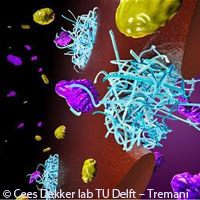Nanopores follow nature's design in tracking proteins
Dutch and Swiss researchers have developed a biomimetic nanopore that offers a sophisticated test and measurement platform for the way proteins enter the nucleus of a cell. This study provides evidence of how a biomimetic nuclear pore can be created to monitor how single proteins move across the pore. Presented in the journal Nature Nanotechnology, the study was partially supported by the EU-funded NANOSCI-EPLUS and READNA projects. Biomimetics is the scientific field whereby human-made processes, substances, devices, or systems imitate nature. In their study, the researchers introduce an artificial nanopore that works together with key proteins mimicking the natural nuclear pore. This innovation enables a new and powerful platform to keep track of how single proteins move. Investigating how individual proteins move through the biomimetic pore, the Delft University of Technology (TU Delft, the Netherlands) and the University of Basel (Switzerland) scientists discovered that the majority of proteins fail to move through while a number of specific proteins succeed. According to the team, the biomimetic pore functions properly and researchers can use it as a testing platform to determine how drugs are delivered into a cell's nucleus. 'Human cells have a nucleus, and proteins and RNA [ribonucleic acid] need to get in and out,' explains Professor Cees Dekker, head of TU Delft's Kavli Institute of Nanoscience and research leader. 'This is regulated by small holes, called nuclear pore complexes. These are essential biological pores that act as gatekeepers of the cell nucleus. They transport proteins and RNA in and out of the nucleus in a highly selective manner, which means that some go through but others are blocked from passing,' he adds. 'There is much debate on how this intriguing selectivity is achieved. Given the fact that it is very difficult to perform high-resolution measurements in the complex environment of the living cell, the exact mechanism is hard to resolve.' Professor Dekker says biomimetics is a promising approach for studying this nuclear transport. 'Advances in nanotechnology now make it possible to study and shape matter at the nanometre scale, opening the way to imitate biological structures at the molecular level to both study and harness their ingenuity,' he points out. The Dekker group produced the biomimetic nanopores by attaching the proteins to small holes in a solid-state support, while his colleague, Basel's Dr Roderick Lim and his team purified the nuclear pore proteins. NANOSCI-EPLUS ('Transnational call for collaborative proposals in basic nanoscience research') has clinched an ERA-NET Plus in Nanosciences grant worth more than EUR 6.3 million under the EU's Seventh Framework Programme (FP7). Led by the French-based institution Centre National de la Recherche Scientifique (CNRS), the NANOSCI-EPLUS project brings together experts from Austria, Finland, France, Germany, Ireland, Israel, Italy, the Netherlands, Poland, Portugal, Slovakia, Spain and the United Kingdom. READNA ('Revolutionary approaches and devices for nucleic acid analysis') is funded under the Health Theme of FP7 to the tune of almost EUR 12 million and brings together business and research experts from Denmark, Germany, France, the Netherlands, Sweden and the United Kingdom.For more information, please visit: Delft University of Technology:http://home.tudelft.nl/Nature Nanotechnology:http://www.nature.com/nnano/index.htmlERA-NET Plus projects:http://ec.europa.eu/research/fp7/index_en.cfm?pg=eranet-projects-homeHealth Research in FP7:http://cordis.europa.eu/fp7/health/
Countries
Switzerland, Netherlands



